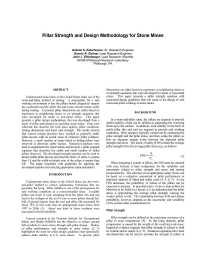Mining Publication: Pillar Strength and Design Methodology for Stone Mines
Original creation date: July 2008
Underground stone mines in the United States make use of the room-and-pillar method of mining. A prerequisite for a safe working environment is that the pillars should adequately support the overburden and the pillar ribs and rooms should remain stable during mining. At present pillar dimensions are either based on experience at neighboring mines or on strength equations that were developed for metal or non-metal mines. This paper presents a pillar design methodology that was developed from a study of pillar performance in operating stone mines. Data were collected that describe the rock mass quality, pillar conditions, mining dimensions and intact rock strength. The results showed that current mining practices have resulted in generally stable pillar layouts with no recent cases of extensive pillar collapses. However, a small number of single failed or failing pillars were observed in otherwise stable layouts. Numerical analyses were used to supplement the observations and develop a pillar strength equation that describes the stable and small number of failed pillars observed. The developed strength equation can be used to design stable pillar layouts provided the factor of safety is greater than 1.8 and the width-to-height ratio of the pillars is greater than 0.8. The paper concludes with guidelines for applying the developed equation and selecting appropriate input parameters.
Authors: GS Esterhuizen, DR Dolinar, JL Ellenberger
Conference Paper - July 2008
NIOSHTIC2 Number: 20034271
Proceedings of the 27th International Conference on Ground Control in Mining, July 29 - July 31, 2008, Morgantown, West Virginia. Peng SS, Mark C, Finfinger GL, Tadolini SC, Khair AW, Heasley KA, Luo-Y, eds., Morgantown, WV: West Virginia University, 2008; :241-253
See Also
- Analysis of Multiple Seam Stability
- Effect of the Dip and Excavation Orientation on Roof Stability in Moderately Dipping Stone Mine Workings
- Effects of Weak Bands on Pillar Stability in Stone Mines: Field Observations and Numerical Model Assessment
- Field Observations and Numerical Studies of Horizontal Stress Effects on Roof Stability in U.S. Limestone Mines
- Pillar Design Issues for Underground Stone Mines
- Pillar Stability Issues Based on a Survey of Pillar Performance in Underground Limestone Mines
- Pillar Strength in Underground Stone Mines in the United States
- Propagation of UHF Radio Waves in Limestone Room and Pillar Mines
- Roof Span Design for Underground Stone Mines
- Simplified Pre- and Post-Processing Technique for Performing Finite-Element Analyses of Deep Underground Mines
- Page last reviewed: 9/20/2012
- Page last updated: 9/20/2012
- Content source: National Institute for Occupational Safety and Health, Mining Program


 ShareCompartir
ShareCompartir
